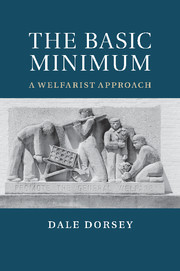2 - A welfarist basic minimum
Published online by Cambridge University Press: 05 March 2012
Summary
The previous chapter ended with a challenge to welfarist approaches to a basic minimum. These theories must avoid the horns of a powerful dilemma: either force people to live lives they do not value, or succumb to the problem of adaptive preferences.
This challenge cannot be met without offering a welfarist theory of the basic minimum. This chapter intends not just to do this, but to show how a welfarist approach can avoid arbitrariness while respecting the importance of an individual's conception of the good while remaining ecumenical between a wide range of theories of the human good. To this end, I offer and argue for an important distinction in welfare goods, beginning in §2.2. Once this distinction is in place, identifying the basic minimum becomes simple, even trivial. In §§2.6–2.7, I identify the basic minimum and defend my account from two important objections. This chapter intends to directly address only the first horn of the welfarist's dilemma; if this chapter succeeds, I will have shown that a non-arbitrary welfarist basic minimum can avoid forcing people to live lives they do not value. I proceed to the topic of adaptive preferences in Chapter 3.
THE DIVERSITY OF WELFARE
Much of this chapter and the next will be dedicated to discussion of human well-being in light of an interest in articulating a welfarist basic minimum.
Information
- Type
- Chapter
- Information
- The Basic MinimumA Welfarist Approach, pp. 35 - 77Publisher: Cambridge University PressPrint publication year: 2012
